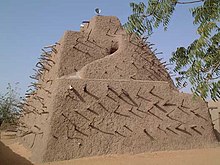| WARNING: Gao has been engulfed in an active conflict between Islamist rebels and Malian troops, backed by an international coalition of West African & French soldiers. The city was liberated from months of Islamist control in early 2013, but tensions remain high and sporadic outbursts of violence have occurred. Kidnapping of westerners occurs on a regular basis. Travel to Gao is highly discouraged, visitors should consult their embassies and remain cautions at all time. More information can be found in the warning box at the top of the Mali page. (Updated Apr 2015) | |
Gao is a small city of 65.000 inhabitants located in the Gao region of Mali.
Understand
The city was founded in the 7th century as a trading post, but it was during the 15th and 16th that the city flourished and its height was the center of the Songhai Empire.
Get in
By plane
Gao has an international airport, and Point Afrique offers flights to Paris and Marseille as well as other cities along the Niger.
By boat
A ferry service links Gao to other cities on the Niger, such as Timbuktu.
By road
Gao is connected to Bamako by a paved highway and can be reached in a private car or by bus. Buses also travel to Niamey several times per week, but the road to the border is still unfinished.
Get around
See

- 1 Grand Mosquée. 14th century Mosque.
- 2 Tomb of Askia (Tombeau des Askia). Constructed in 1495 by Songhai emperor Askia Mohamed Toure, the Askia Tomb (known locally as the Askia Mosque) is a mud-brick pyramid designed to look like the Great Pyramids of Egypt, which Mohamed saw on his pilgrimage to Mecca. Today it is still used as a mosque and is a UNESCO World Heritage site. (Note: This has reportedly been destroyed or been significantly damaged/defaced by Islamist rebels for being 'idolatrous' during their occupation of Gao in 2012. These are the same people responsible for the destruction of Timbuktu's shrines.)
- 3 Sahel Museum (Musée du Sahel).
- 4 La Dune Rose. A giant sand dune across the river from Gao, named for its glowing pink color at sunrise and sunset. Best reached by pirogue. The top has beautiful views of the surrounding landscape, especially after the rainy season.
Do
Buy
- Traditional markets. The vegetable and meat markets are in the center of town beside the river. They feature the usual assortment of produce and spices as well as blocks of salt mined in the far north of Mali. The Marche Washington, down the road towards the Askia Tomb, sells clothing and fabric and is full of tailors at work.
Eat
Drink
Sleep
- 1 Hôtel Atlantide. Built in 1932, it has some claim to fame for being one of the oldest hotels in the Sahel. Damaged in the recent fighting it has been closed for the last three years but is expected to open again in late 2015.
Go next
Buses leave Gao for Bamako two-three times per day. Buses also travel to Niamey several times per week, but the road to the border is still unfinished.
